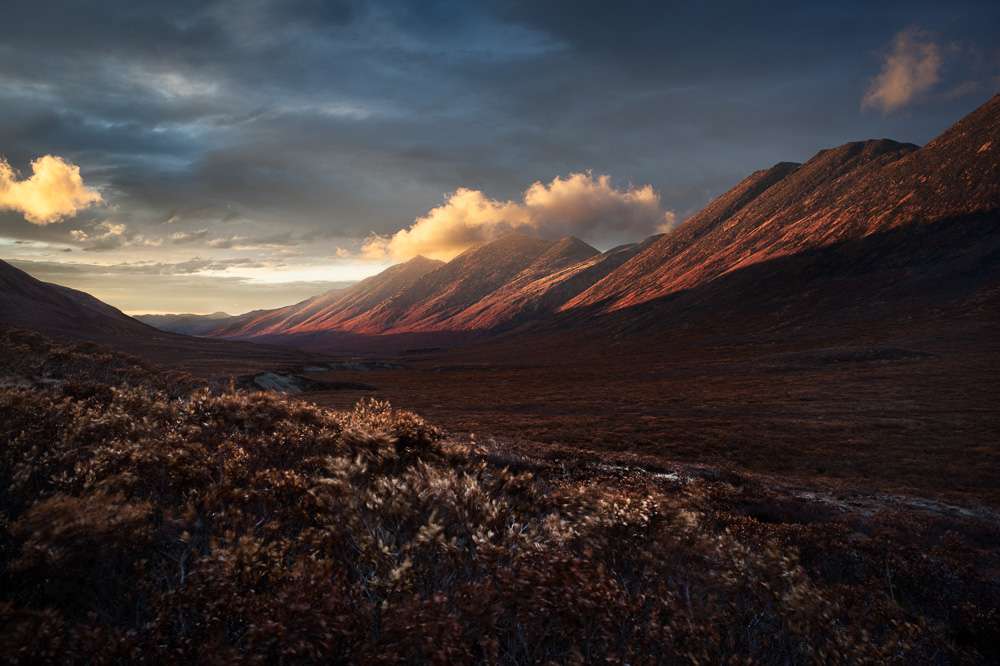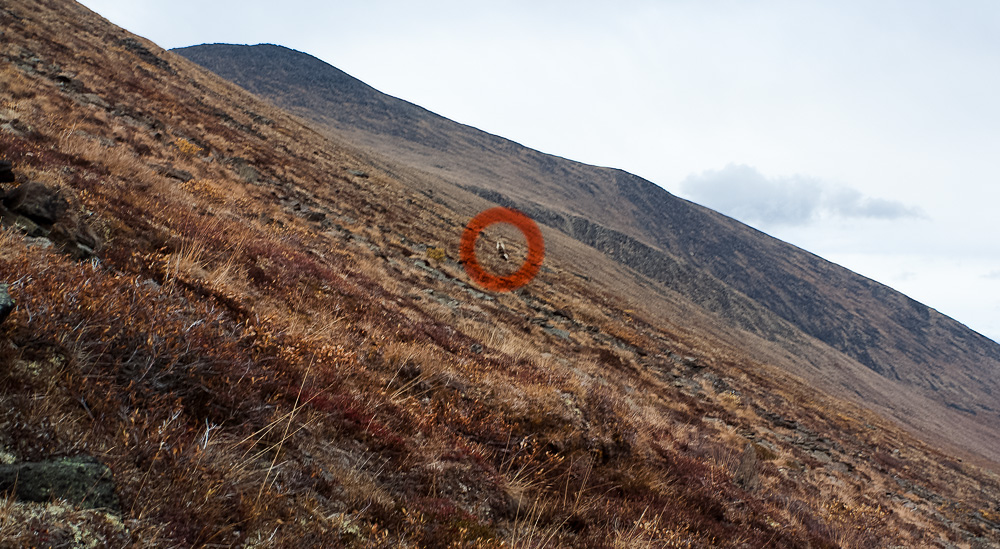
“Are you lost?” This was not quite going as planned. I had not even walked more than a few hundred meters and despite carrying pretty much every kind of navigation device known to mankind, I had stumped into a dead end. Lost in a resident's backyard. Also, my water bottle was missing.
He was standing on the porch, one hand above his forehead, shielding his eyes from the early afternoon sun. It took me a few tries to explain that, in fact, I did not want to climb the small mountain that the rare tourist up here likes to conquer. I wanted to to go past that mountain. Way past, several days into the mountain range. He stared at me with a mixture of confusion and terror, clearly wondering why in heaven's name I would want to do that. But he only asked me the questions that I had already heard a few times this morning: When I was planning to be back, whether someone knew where I was going and whether I was carrying one of those barrel-sized pepper spray cans. I did, and it was dangling in front of my chest between several kilograms of camera gear. It was September, after all, which up here in Northern Canada translates to a lot of grumpy bears desperately trying to get into a presentable shape before the onset of winter.
The maps of the area were completely unreliable, he told me, and he took the time to carefully direct me to the right starting point of my private little expedition. He seemed to be a little more reassured by now, but I could tell that my little blunder had not exactly inspired him with confidence. It did not help that I came from a faraway land and had only limited hiking experience in this area.
I strapped on my gear and thanked him profusely. Then I started walking into the direction he had pointed, my heavy backpack towering over my head. Before I was swallowed by the forest, I stumbled across my dearly missed water bottle. “Good luck!” had been his last words, “You will need it!”.
On the third day, I ran into trouble. More precisely, that was when I began running into trouble. It did not get much better after that.
To keep up with my rather ambitious itinerary, I covered a lot of distance on the first day. My arms were riddled with mosquito bites, ranging in size from golf ball to tennis ball, but all in all, everything was well. My destination for the day was a place next to a small stream where I would put up my tent and stock up on water, and I actually made it there. Yet, to my surprise, there was no stream. Erratically walking several hundred meters into every direction did not change that. So I cursed the cartographers of my maps with seven years of drought and went to sleep thirstily.
I spent the next two days crossing rivers and mountains, balancing over fields of man-sized rocks, wading through swamps and fighting the thick, stubborn brush. Oftentimes, I barely made a few hundred meters in an hour. Narrow, well-trodden moose tracks allowed me to bypass some of the worst challenges at the expense of nervously looking over my shoulders and freezing solid at any noise. Late fall is the time of moose rut, so the males can be quite territorial. And at the moment, I did not quite feel like being chased trough the brush by a vicious three-quarter ton of antlers and muscles.

The weather had been quite tame, but the higher up I marched into the mountains, the windier it became. I had pulled the hood of my jacket deep into my face to stay warm. Slowly pushing myself up a bleak, featureless mountainside covered with rocks and low bushes, I did not see it coming. For a fraction of a second, from the corner of my left eye, I thought I was seeing a boulder rolling downhill to cross my path. Then I noticed that I had never seen such a fluffy boulder. Much less one that was staring me down while moving into my direction, sporting claws and fangs big enough to use as an ice axe. That boulder was a grizzly bear. A grizzly bear mother, more precisely, with three cubs that were tumbling down the slope behind her. She stopped about 20 meters ahead of me, never taking her eyes off me while the little ones played hide and seek between her enormous paws. After a second of being completely stunned, I slowly lifted my hands into the air and politely introduced myself. I gave my best to appear as much human and as little caribou as possible.
This was not the first time I had encountered grizzly bears, but all the other times I had been in company and there had at least been a car with an open door between me and the bear.
My gaze yo-yoed between the bear and the pepper spray. This time I was alone, roughly 40 kilometers from the next road, on a silver platter. Not even a tree to hide behind. The only things standing between me and a row of nasty teeth was her goodwill and a glorified spice shaker.
The cubs were reassuring and unsettling at the same time. On one hand, she probably would not try to pull off any stunts to not risk any harm to her spawn. On the other hand, if she decided that I was a threat or nuisance to them, this could get ugly very quickly.
She drew herself up to her full height. Cautiously, she started sniffing. I was relieved: She was still curious and undecided. Also, with the exception of a moderately successful bath in an ice cold river, I had not showered in almost five days. I probably smelled less tasty than usual.
She dropped down on all four and hesitated. Then she made one step forward. And another one. Wrong direction! My right hand dashed towards the pepper spray. But before I could rip it out of its case, she changed her mind, turned around and bolted off into the opposite direction. The little ones were following her, trailing slightly behind. After a moment of confusion, I hastily yanked out my camera and managed to take one blurry shot before they disappeared behind a ridge. This encounter had ended as quickly as it had begun.
Still a bit shaken, I tried to process what had happened. I had just had a standoff with a grown grizzly bear ‐ and she retreated. So technically, I had won. There was even a picture to prove it. I could not help but grin.
It worried me a little that she had run off into the direction I wanted to go, but I decided to make more noise and yell once in a while to shoo away any beasts that lived up here in the mountains.

Several hours later, I was climbing across boulders just below the mountain summit, next to a large snow field that had somehow survived the summer. I was just a few meters away from my final destination: A large Douglas C-47 Skytrain plane wreck that had spent the last 65 years relatively undisturbed at the top of the mountain.
In the winter of 1950, a fully seated U.S. Air Force transportation plane, a Douglas C-54 Skymaster, went missing when flying from Alaska to the south. 44 people disappeared without a trace. This triggered one of the largest search and rescue operations in the history of the US military during which several search planes crashed. One of them was the C-47 I was looking for. Sweeping the area at low altitude and in harsh weather, it was caught by a downdraft and pushed into the snow-covered mountainside. Some of the crew were injured, but everyone got away with their life.
Shortly after, a B-36 bomber carrying a nuclear bomb went missing further south in British Columbia, so the priorities shifted from the lost C-54 and its crew to frantically trying to find the nuke. The search in the Yukon was called off and the crashed search plane was left to be taken by the elements.
Two thirds of a century later I slowly made my way to its position. I could not see it yet, but from the mark on my map I knew that it was right behind the moutainside. Passing said mountainside, however, all I could see was moss and rocks and another mountainside. I kept walking. This little game repeated itself three or four times and every single time I was presented an empty landscape devoid of any signs of the wreck. A very unpleasant suspicion gradually crept up my back.
I dropped my gear and pulled out the documents and pictures of the wreck that I had brought. I looked around, then at the pictures, then around again. This place looked different. The surrounding landscape looked different. I was on the wrong mountain. God damn it!
I had spent several months with research and preparation before coming here. I had asked and cold called a plethora of different people, but of the few who had answered, no one was able to give me the exact location. So I had decided to figure it out on my own. Somewhere along the way I must have made a mistake and now I was standing in the middle of nowhere with no clue where to find the wreck. It could be just around the corner, it could just as well be dozens of kilometers away. I had no way of knowing. And I certainly could not search hundreds of square kilometers on foot for a wreck that could only be seen when standing on the mountain above it. In a few days, I would be running out of time and food.
I had spent all that time and money and energy, had come halfway around the globe and endured several days of strenuous hiking, only to fail so short of the goal. Because I had been so sure of the location that I had not bothered to verify it one more time.
Helplessly sitting down on my backpack, I flicked trough the pictures of the wreck and stared at them in disbelief.
Then I noticed something. Something looked oddly familiar. It took a moment, then it hit me: In the far background of one of the pictures, on the side of one of the mountains, there was a distinctively shaped snow field. I turned around. Yes, this looked roughly like the same snow field that I had just walked past. I checked it several times, then the shape of the mountain and any other features I could find. Hallelujah! I was on the mountain next to the one with the wreck! All I had to do was descend a few hundred meters, ascend on the other side of the valley and traverse the mountain. Instead of having to abandon the whole project, I would only lose one day. I had enough time left to afford that.
I set up camp and stashed my food much further away from my tent than the nights before. Then I went to sleep, the pepper spray lying next to my pillow.